WWW.RIFLEMAN.ORG.UK AND THE ROYAL ARMOURIES


N.B. ALL IMAGES ON THIS PAGE ARE COPYRIGHTED TO BOTH
WWW.RIFLEMAN.ORG.UK AND THE ROYAL ARMOURIES


For readers already aware of the British EM-2 rifle, of .280in calibre,
some interesting facts lie within the history of
that rifle's development at the Royal Small Arms Factory, Enfield.
It is not generally known that the original designation
for the RSAF bull-pup design was as the Enfield Rifle No.9.
It was soon realised that this nomenclature had already been put into use,
so the obvious progression was to award the next number , for Enfield Rifle No.10.
For reasons not entirely clear, but probably related to the then imminent change
of nomenclature from plain rifle numbers to the currently employed system of "L" prefixed codes,
(to such as the L1A1 for the incoming NATO selection of the Belgian designed self-loading rifle, or "SLR")
the prototype was named on drawings as the "X1 E1";
both "X" and "E" often being prefixed to the numbers of 'Experimental' weapons.
Below: the "battle-ready" example of the 'standard' EM-2 that lies on display in the collection of the Small Arms School at Warminster.
The bayonet bears more than a passing resemblance to the less common option for the earlier Lee-Enfield No.4 rifle,
the swivelling-pommel No.7 Mk.I bayonet .
The grooved hand-hold is a separate component affixed to the fore-end furniture.

The photographs of the next 'standard' EM-2 rifle are by courtesy of
the Small Arms Collection of the Defence Academy at Shrivenham, Wiltshire.

There are notable differences between this rifle and the Warminster example.
The fore-end's hand-hold grooving is at variance, and in one piece with the furniture.
as is the steel side pressing above the pistol-grip on the right-hand-side.
The trigger-guard is more angular, and the trigger is a flate plate type.

The frequently published 1951 dated photograph below shows two British soldiers
at the military demonstration described in the NYB report attached.
The nearest is one Corporal Unwin, holding the "new" EM-2 (short-lived) service rifle.
This model is as the Warminster example above.
To his left, another soldier carries the outgoing Lee-Enfield No.4 rifle, soon to be replaced by the Belgian
FN Self-Loading Rifle (SLR) to be afforded the upcoming new nomenclature "Rifle, L1A1".
 PLA A 97666 NEW YORK BUREAU
PLA A 97666 NEW YORK BUREAU
NEW RIFLE HIGHLY PRAISED
WARMINSTER, ENGLAND. THE NEW BRITISH SERVICE RIFLE (FOREGROUND),
HELD BY CPL.E.UNSWORTH, WAS HIGHLY PRAISED AFTER A DEMONSTRATION
BEFORE 200 RANKING OFFICERS OF THE U.S.A., THE BRITISH COMMONWEALTH
NATIONS, AND OTHER FRIENDLY COUNTRIES,INCLUDING YUGOSLAVIA.
DEVELOPED AFTER FIVE YEARS OF INTENSIVE RESEARCH,THE .280 IS ALMOST A
FOOT SHORTER THAN THE U.S. GARAND, MORE THAN A POUND LIGHTER AND CARRIES 20
ROUNDS TO THE GARAND'S EIGHT.A RADICAL DEPARTURE IN DESIGN, IT IS EQUIPPED WITH
AN OPTICAL SIGHT, AND THE WOODEN STOCK HAS BEEN ELIMINATED. IN THE BACKGROUND IS
THE STANDARD BRITISH BOLT-ACTION .303 RIFLE, WHILE IMPRESSED WITH
THE SEVERAL FEATURES OF THE NEW WEAPON, U.S. OBSERVERS INDICATED LITTLE
LIKELIHOOD THE U.S. WOULD OR COULD SWITCH AT THIS TIME.
NY-1-2-3-4-5 CAN MX SA MGS
CREDIT (ACME) 8/11/51 (PS)
Recent publicity, of the hitherto all but "forgotten" EM-2 rifle, has raised discussion of the political reasoning
behind the selection of the 7.62mm round as the new NATO rifle ammunition, and the demise of what has often been deemed,
in the ensuing years, to have been an error in dismissing the .280in round and its well-designed and practical weapon of projection.Even now, the EM-2 appears almost modern, apart from the aesthetically pleasing and traditional
employment of walnut furniture, rather than green or black composite material.The text of the report makes quite clear the fact that a decision not to approve the EM-2, and its .280 calibre ammunition,
as a NATO service weapon, had been made by the United States long before the rifle's appearance at this demonstration.Some of the factors then involved are discussed in the documents available on both this page and that for the EM-1 rifle.
The EM-2's progression from the EM-1 Rifle was made over several years, between 1951 and 1954,
during which time various trials and costings resulted in the selection of
the Fabrique Nationale designed self-loading rifle, in 7.62mm NATO calibre,
as the next British individual Service Weapon.
 ..
.. 
Above left: the gently curved magazine for the new rimless cartridge.
Above right: the full-length rifle's muzzle, showing the Lee-Enfield No.4 rifle form
of barrel lugs that locate the bayonet, of aforementioned No.7 swivelling-pommel type.
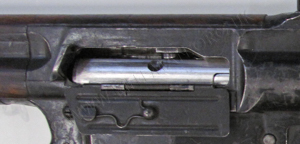 With the spring-loaded
With the spring-loaded
ejection port open,
bolt is visible.
In 1951 an article was written, covering the introduction of the EM-2
during a meeting at the home of the Small Arms School at Warminster, Wiltshire.
Below is a searchable facsimile of the document, may take a few moments to display.
N.B. The search magnifier may need to be clicked twice.
It was remarkable that the EM-2 had rate of fire near twice that of the U.S. M1 Garand service rifle and,
if the above article is correct, with significantly greater hitting power.
The smaller .280 calibre probably also resulted in the advantage of a flatter trajectory.
This last factor was later repeated with the introduction of the 5.56mm round,
its British service rifle, the SA80, (or L85A1) and its successor, the L85A2.
We cover on site the SA80's training equivalent, the now obsolescent straight-pull Enfield Cadet Rifle, L98A1, and the L98A2.
The mention in the article of the rifle being capable of use by gloved hands,
does not mean there was just a modified cocking-handle,
as was the case on the alpine models of the Swiss Schmidt-Rubin rifles;
but rather that a fully specialised "Arctic" model of the EM-2 had been produced.
The trials rifle of this type is shown further down this page.

We show below the Prototype of the "Short Rifle", effectively the carbine, or paratrooper's version,
held in the National Firearms Collection at the Leeds Royal Armouries,
in common with the following examples illustrated on this page.

This rifle has the same general features as the Warminster example.


Here viewed from above and below.

And a close-up of the center section.

The sight picture through the early optic unit, incorporated into the rifle's carrying handle, is shown right.
The inverted reticle pointer was employed, and magnification was minimal.
The old target is from the Solano training series.
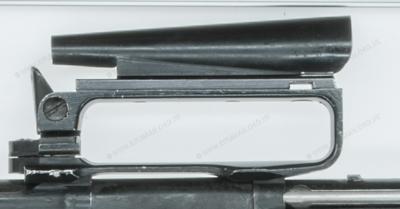 ...........................
...........................
The heavily grooved hand-grip was a quite marked and unusual feature.
The cocking-lever handle is in the upper center-left of the photograph.

Unusually, the front sling-swivel was mounted on the top of the fore-end rather than below.
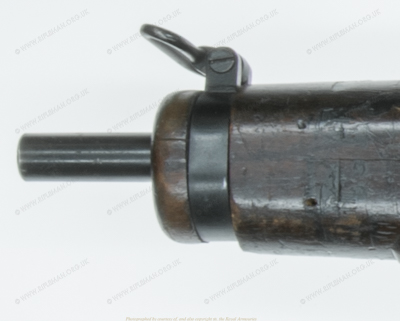
The "straight-line" configuration of the rifle ended with a simple butt-plate with a rubber recoil pad insert,
and the rear sling-swivel at its base.

As previously mentioned, number of prototype and trials rifles were produced,
by BSA, of a rifle specifically designed for cold climes.
This was designated the "Arctic Model", with a very special trigger configuration for use by heavily gloved hands.





 The magazine and ejection port cover are shown left,
The magazine and ejection port cover are shown left,
and the rubber recoil padded light-weight butt-plate to the right.
The carrying handle with intergral optical sight is shown below.
The rather agricultural appearance suggests that the sight unit
and its mounting would have proved significantly more robust than those
of the current SA80 service weapon,
although the optics were rather less sophisticated.

That the rifle can be used with very heavily gloved hands, indeed mittens, is apparent from the photograph below.

 .....................................
..................................... 
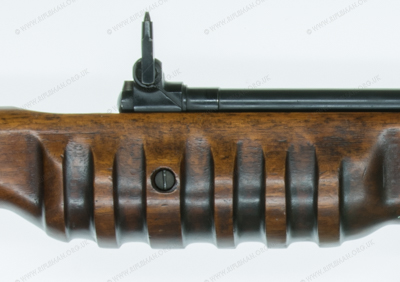
And finally, an image of the magazine, with a .280 inch round on the staggered follower platform,
with another round stood alongside.

A proof manual was produced for the rifle's trials users.
It is illustrated below as a flip-page booklet.
N.B. Two pages (23 & 24) were missing from the original.
Double tap tablet or click ![]() for full page display.
for full page display.
View a Pathe news clip of the rifle in use at a contemporary 1950's military demonstration.
This would quite possibly have been the same international event described in the New York Bureau's news report attached to the photograph,
already here illustrated, of Corporal Unworth and a colleague respectively carrying the EM-2 and Lee-Enfield No. 4 rifles.
One of the earliest mentions of Enfield's design of the .280" calibre rifle was a brief description of the weapon, detail of which was still restricted. Major W.G.B.Allen afforded what little was then permissible in his book "Pistols, Rifles and Machine-guns" published in 1953.
The relevant extract is shown below.
This can be viewed as a text-searchable flip-page document
or with vertical scrolling by clicking the portrait icon.
Depending upon the number of pages it may take a few moments to load.
Double tap tablet or click ![]() for full page display.
for full page display.
The above extract is from Chapter 11 of Allen's book, and the whole section on service rifles used at the time, covering the Lee-Enfields of several marks and the U.S. Garand and Russian Nagant can be viewed HERE - "RIFLES" by Allen.
_________________
An informative article affording a brief history of the development of British Self -Loading Rifles between 1900 and 1914 was written by Peter Labbett and published in the June 1964 edition of Guns Review Magazine.
The searchable article is replicated below as a flip-page facsimile.
Double tap tablet or click ![]() for full page display.
for full page display.
In April 1961, Peter Labbett had already written an article asking the worthy question
"Was the finest rifle thrown out?"
This was also published in Guns Review.
This can be viewed as a text-searchable flip-page document
or with vertical scrolling by clicking the portrait icon.
Depending upon the number of pages it may take a few moments to load.
Double tap tablet or click ![]() for full page display.
for full page display.
A later related article was written by John Weeks
in the July and August 1976 issues of Guns Review.
It was entitled "A New British Weapon".
Covering the introduction of the 4.85mm precursors to the
SA80 personal (individual) weapon, and the Light Support Weapon ( LSW).
it well illustrated the legacy belonging to the EM2 design.
It is shown in its two separate parts.
An EM2 in its transit chest
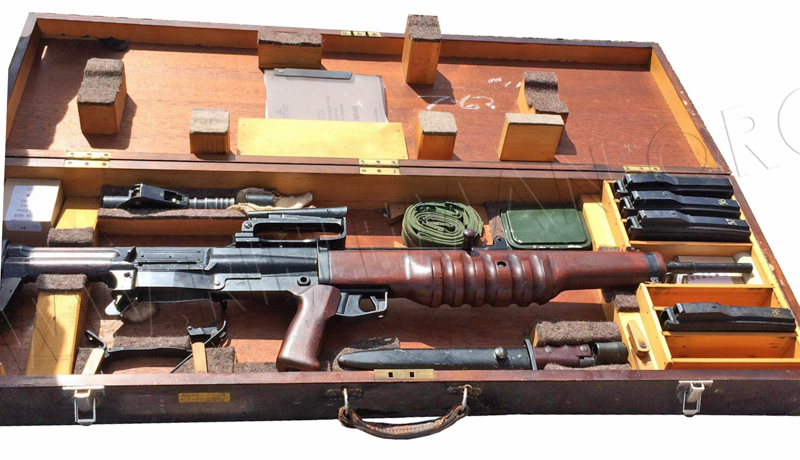
Thank you for taking the time to view this page. We hope it has been of interest
Click here for Chronology of Enfield genre Training Rifles, Adapters & Cartridges
Contact - email: Miniature-Calibre-Rifles@rifleman.org.uk
* "EM-2 Concept and Design", 1980 by Thomas B Dugelby
Return to: TOP of PAGE
See this website's Raison d'être